Given that \[5x^2 + 2y^2 − 6xy + 4x − 4y \equiv a (x − y + 2)^2 + b (cx + y)^2 + d,\] find the values of the constants \(a\), \(b\), \(c\) and \(d\).
We will do this by expanding the right-hand side and comparing coefficients with the left-hand side. The right-hand side becomes \[(a+bc^2)x^2 + (a+b)y^2 + (2bc-2a)xy + 4ax - 4ay + 4a + d.\] Comparing coefficients with the left-hand side yields the following six equations:
\(a+bc^2=5\),
\(a+b=2\),
\(2bc-2a=-6\),
\(4a=4\),
\(-4a=-4\),
\(4a+d=0\).
Equations 4 and 5 tell us that \(a=1\). Substituting this in to equation 6 yields \(d=-4\). From equation 2 we find that \(b=1\). Equation 3 then gives \(c = -2\), and this also works in equation 1. So we have \[5x^2 + 2y^2 − 6xy + 4x − 4y \equiv (x − y + 2)^2 + (-2x + y)^2 -4.\]
Since the first part of the question told us to write the left-hand side of the first equation in a special form, perhaps we should try to write the left-hand side of the second equation in the same form.
Using the same technique as in the first part of the question, attempting to write \[6x^2 + 3y^2 − 8xy + 8x − 8y \equiv a (x − y + 2)^2 + b (cx + y)^2 + d,\] we get the following six equations:
\(a+bc^2=6\),
\(a+b=3\),
\(2bc-2a=-8\),
\(4a=8\),
\(-4a=-8\),
\(4a+d=0\).
This time, equations 4 and 5 show that \(a=2\), then equation 6 gives \(d=-8\), and then \(b=1\) by equation 2. Then equation 3 gives \(c = -2\), and this also works in equation 1.
So now let us try to solve the simultaneous equations \[\begin{equation} (x − y + 2)^2 + (-2x + y)^2 -4=9, \label{eq:1} \end{equation}\] and \[\begin{equation} 2(x − y + 2)^2 + (-2x + y)^2 -8=14.\label{eq:2} \end{equation}\] Looking at these two equations, we see that if we subtract them in certain ways, we get simpler equations, for example \(\eqref{eq:2}\)\(-\)\(\eqref{eq:1}\) yields the equation \[(x-y+2)^2-4=5,\] which simplifies to \[\begin{equation} x-y+2=\pm3. \label{eq:3} \end{equation}\] We now cancel the first term instead, by calculating \(\eqref{eq:2}\) \(-2\times \eqref{eq:1}\). We get \[-(-2x+y)^2=-4,\] which we simplify to find \[\begin{equation} -2x+y=\pm2. \label{eq:4} \end{equation}\]We now solve the four pairs of simultaneous equations given by \(\eqref{eq:3}\) and \(\eqref{eq:4}\).
\(x-y+2=3\) and \(-2x+y=2\) gives \(x=-3\), \(y=-4\).
\(x-y+2=-3\) and \(-2x+y=2\) gives \(x=3\), \(y=8\).
\(x-y+2=3\) and \(-2x+y=-2\) gives \(x=1\), \(y=0\).
\(x-y+2=-3\) and \(-2x+y=-2\) gives \(x=7\), \(y = 12\).
We briefly check using the equations we were given in the question that we have the correct solutions:
For \(x=-3\) and \(y=-4\), \[45+32-72-12+16=9 \; \checkmark \quad\text{and}\quad 54+48-96-24+32=14\; \checkmark\]
For \(x=3\) and \(y=8\), \[45+128-144+12-32=9 \; \checkmark \quad\text{and}\quad 54+192-192+24-64=14 \;\checkmark\]
For \(x=1\) and \(y=0\), \[5+4=9 \; \checkmark \quad\text{and}\quad 6+8=14 \;\checkmark\]
For \(x=7\) and \(y=12\), \[245+288-504+28-48=9 \;\checkmark \quad\text{and}\quad 294+432-672+56-96=14 \; \checkmark\]
The equations we are given in the question in fact represent ellipses, and we know that two ellipses can meet in at most four points. (This is an example of Bézout’s Theorem.) The two curves in the question are graphed below.


